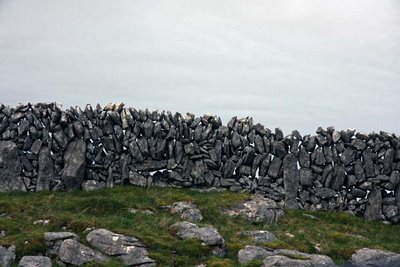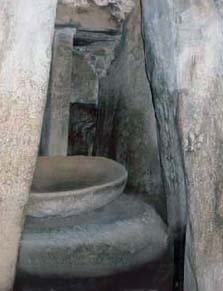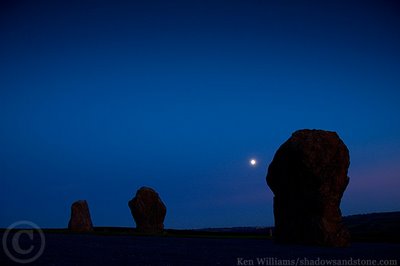 You might remember this labyrinth from the Snæfellsnes peninsula in Ísland…
You might remember this labyrinth from the Snæfellsnes peninsula in Ísland…
 …and this Inukshuk from Mallikjuag in Nunavut.
…and this Inukshuk from Mallikjuag in Nunavut.
 In truth, we’ve been traveling in a world of stone for a long time now.
In truth, we’ve been traveling in a world of stone for a long time now.
 The passage tombs at Brú na Bóinne in County Meath in Ireland are 5,000 years old. They’re older than Stonehenge or the Pyramids.
The passage tombs at Brú na Bóinne in County Meath in Ireland are 5,000 years old. They’re older than Stonehenge or the Pyramids.
 The white-quartz walls, like here at Newgrange, had long been fallen…
The white-quartz walls, like here at Newgrange, had long been fallen…
 …so that the passage tombs appeared as natural hill forms for four millennia – despite the old stories of the uncanny that people in the Boyne Valley told.
…so that the passage tombs appeared as natural hill forms for four millennia – despite the old stories of the uncanny that people in the Boyne Valley told.
 When the existence of the passage tombs beneath the mounds was re-discovered a couple centuries ago, it was unthinkable that these human structures could have been over 5,000 years old.
When the existence of the passage tombs beneath the mounds was re-discovered a couple centuries ago, it was unthinkable that these human structures could have been over 5,000 years old.
After all, that would have meant they pre-dated the origin of the universe as a whole.
 When you think about it, you realize that there are a finite number of elemental, archetypal forms the human hand might make – or might want to make.
When you think about it, you realize that there are a finite number of elemental, archetypal forms the human hand might make – or might want to make.
 Spirals, diamonds…
Spirals, diamonds…
 …pits, cupules, radiating sunburst lines…
…pits, cupules, radiating sunburst lines…
 …and mandalas of every form.
…and mandalas of every form.
 The depiction of the human form itself seems relatively a late development.
The depiction of the human form itself seems relatively a late development.
 This is even true for early Celtic Christian stones.
This is even true for early Celtic Christian stones.
Perhaps this was because the human presence was so self-evident. Perhaps it was because what sites of ritual once wanted to record was not “look, we, too, are here” – but rather, the elemental wholeness within which humans once found themselves.
 An elemental wholeness not lost to all of us, it is true.
An elemental wholeness not lost to all of us, it is true.
 And it is also true that not all early human markings appear in pre-Celtic lands.
And it is also true that not all early human markings appear in pre-Celtic lands.
For instance, this is one of the most striking places that we know – back home in the Sur. And all during this current journey that we’re on, this stone keeps calling out to us.
 It is likely as old, or older, than Brú na Bóinne. It may pre-date the arrival of both Hokan and Penutian-speaking peoples along the California coast. And if so, it was made by people we don’t know how to name…
It is likely as old, or older, than Brú na Bóinne. It may pre-date the arrival of both Hokan and Penutian-speaking peoples along the California coast. And if so, it was made by people we don’t know how to name…
 …in a land whose calendar follows the seasons of the oaks.
…in a land whose calendar follows the seasons of the oaks.
 And as we travel – particularly now in this winter season of inwardness and recollection – we remember you who are traveling in your own way, too. Many of you to places of memory, joy, and loss…
And as we travel – particularly now in this winter season of inwardness and recollection – we remember you who are traveling in your own way, too. Many of you to places of memory, joy, and loss…
 …to holy places of your own…
…to holy places of your own…
 …to celebrate and mourn…
…to celebrate and mourn…
 …those who have gone before us,
…those who have gone before us,
 …a great cloud of witnesses – the living and the dead.
…a great cloud of witnesses – the living and the dead.
 No one can really be sure of the function of places like Brú na Bóinne. It was once presumed that a “passage-tomb” was a burial place for the dead – except that there’s no empirical evidence for this.
No one can really be sure of the function of places like Brú na Bóinne. It was once presumed that a “passage-tomb” was a burial place for the dead – except that there’s no empirical evidence for this.
 Perhaps they were ritual centers instead -- places to commemorate the dead and to help spirit them along in their journeys -- much like a church or cathedral now.
Perhaps they were ritual centers instead -- places to commemorate the dead and to help spirit them along in their journeys -- much like a church or cathedral now.
In fact, there are striking architectural similarities.
 Let us illustrate from our later visit to the 9th century church of Epyphanius at San Vincenzo al Volturno in Italy.
Let us illustrate from our later visit to the 9th century church of Epyphanius at San Vincenzo al Volturno in Italy.
 Churches and cathedrals are often aligned with the solar equinox.
Churches and cathedrals are often aligned with the solar equinox.
Right now you’re standing in the nave in the east, looking west. Over the shoulder of architect Franco Valente is the base of the altar stone. Below that is the window to the crypt.
 When you look exactly west – as if you were the rising sun on the equinox – you’ll see how aligned are the altar stone and the window to the crypt.
When you look exactly west – as if you were the rising sun on the equinox – you’ll see how aligned are the altar stone and the window to the crypt.
 Photo by Ken Williams, from Newgrange.com
Photo by Ken Williams, from Newgrange.com
The 5,000 year old passage tomb at Newgrange is aligned with the sun as well. But it is aligned with the winter solstice.
Precisely aligned.

Here is an overall map of some of the major monuments in Brú na Bóinne. You'll see the Newgrange passage tomb in the center. And again, its own passageway -- depicted in the photo above the map -- is exactly aligned with sunrise on the winter solstice.
And the interiors of both passage tomb and cathedral are generally cruciform in their floor plans.  In this aerial plan of the crypt of Epyphanius, the tomb is that of the abbot Epyphanius. Below the tomb is the window into the crypt that you saw before.
In this aerial plan of the crypt of Epyphanius, the tomb is that of the abbot Epyphanius. Below the tomb is the window into the crypt that you saw before.
So the sun runs the length of the nave from the east, passes through the window over the tomb, and then strikes the western wall.
 Specifically, it strikes a fresco of Christ – in angelic form from the book of the Apocalypse.
Specifically, it strikes a fresco of Christ – in angelic form from the book of the Apocalypse.
That figure is above my head, flanked from left to right by Gabriel, Raphael, Michael, and Uriel. Obviously, this is interior electric light, so you don’t get the solar equinoctial effect.
 Now you’re looking north down into the crypt yourself. The image of Christ is on the back wall to your left. And the tomb – and window into the crypt – is in the recess to your right.
Now you’re looking north down into the crypt yourself. The image of Christ is on the back wall to your left. And the tomb – and window into the crypt – is in the recess to your right.
 In the interior chambers of passage tombs like Newgrange, there are ritual basins that can remind you of birthing stones or baptismal fonts. They feel “feminine” -- places for water in the darkness – as interior complements to the solar alignment of the whole.
In the interior chambers of passage tombs like Newgrange, there are ritual basins that can remind you of birthing stones or baptismal fonts. They feel “feminine” -- places for water in the darkness – as interior complements to the solar alignment of the whole.
 And as you bow and crouch and move inside along the passageway, without noticing it, your feet are moving along a precisely calculated incline.
And as you bow and crouch and move inside along the passageway, without noticing it, your feet are moving along a precisely calculated incline.
 Photo by Ken Williams, from shadowsandstone.com
Photo by Ken Williams, from shadowsandstone.com
OK. So let’s imagine it. It’s winter solstice night.
Only a small group of elders or priests can fit inside the small interior chamber. The rest of the people wait outside under the open sky – with prayer and fire and dance and chant.
It is the greatest festival of the year.
 But you are one of those inside – waiting in utter darkness in a small stone room that feels like a tomb.
But you are one of those inside – waiting in utter darkness in a small stone room that feels like a tomb.
 Then you begin to notice it. A thread of light is creeping along the floor of the narrow passageway.
Then you begin to notice it. A thread of light is creeping along the floor of the narrow passageway.
It reaches the beehive central chamber and diffuses into a honey-glow.
Then a moment later, exactly at 8.52, the thread strikes the center of the recessed back wall like an arrow from the heart of light itself.
 The light in the chamber lasts for exactly seventeen minutes.
The light in the chamber lasts for exactly seventeen minutes.
You’ve been waiting for it all year.

 Tuesday, December 23, 2008 at 12:41AM
Tuesday, December 23, 2008 at 12:41AM 















 In fact, the community was so important to us that we named our daughter Caitlin after the monastery. She’s Caitlin Shaw Lorenc. (Shaw because Debi put her foot down and insisted that Shaw was a more tolerable middle name for a baby girl than my own first choice…Rock.)
In fact, the community was so important to us that we named our daughter Caitlin after the monastery. She’s Caitlin Shaw Lorenc. (Shaw because Debi put her foot down and insisted that Shaw was a more tolerable middle name for a baby girl than my own first choice…Rock.) And sure enough it’s been nothing but ora et labore for Caitlin ever since.
And sure enough it’s been nothing but ora et labore for Caitlin ever since.



























































